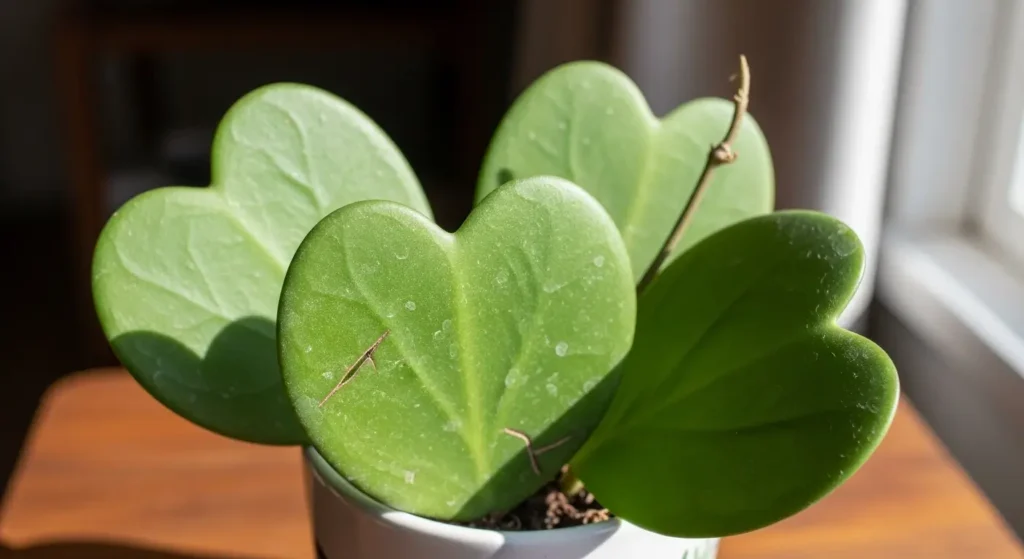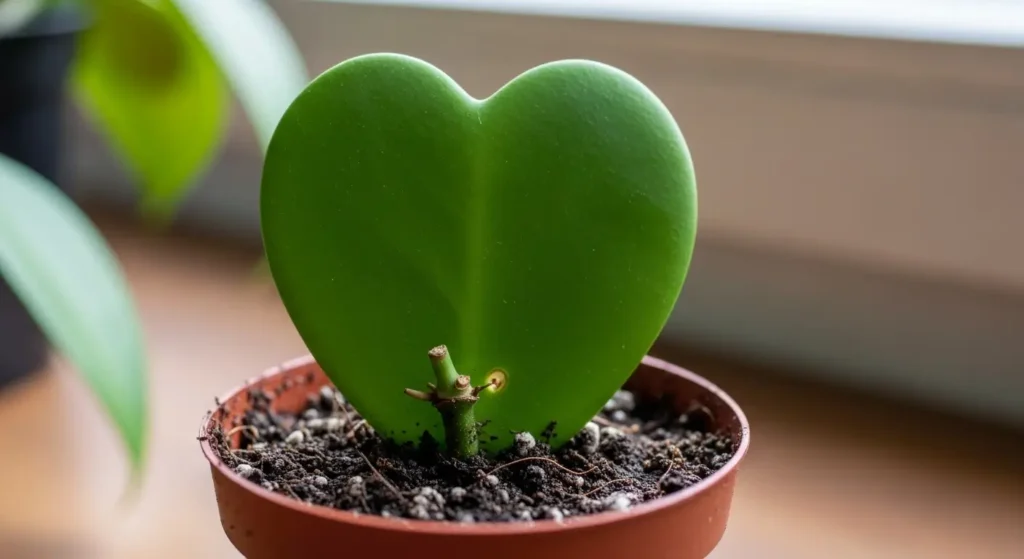
In This Article
Meet the Hoya kerrii, affectionately known as the Sweetheart Plant or Valentine Hoya. This adorable succulent-like houseplant features perfectly heart-shaped leaves that make it a popular gift for plant lovers. Native to Southeast Asia, particularly Thailand and Vietnam, this tropical plant has captured hearts worldwide with its charming appearance and low-maintenance nature. The thick, waxy leaves store water, making it more drought-tolerant than typical houseplants. If you can remember to water it occasionally and give it decent light, you’ll have a happy Hoya kerrii thriving in your home.
Plant Care Card
| Common Name | Hoya Heart, Sweetheart Plant, Valentine Hoya |
|---|---|
| Botanical Name | Hoya kerrii |
| Family | Apocynaceae (Dogbane family) |
| Plant Type | Tropical perennial succulent |
| Mature Size | Climbing vine up to 13 feet; compact when pruned |
| Sun Exposure | Bright indirect light |
| Soil Type | Well-draining, airy potting mix |
| Soil pH | 6.1 to 7.5 (slightly acidic to neutral) |
| Hardiness Zones | 11-12 (USDA); typically grown indoors |
| Native Area | Southeast Asia (Thailand, Vietnam, Laos) |
| Toxicity | Non-toxic to cats and dogs |
Hoya Kerrii Care
This plant is surprisingly low-maintenance once you understand its basic needs. The following sections cover everything from light requirements to common problems. With the right care routine, your Hoya kerrii will reward you with steady growth and fragrant blooms.
Light
Your Hoya kerrii thrives in bright, indirect light—think a spot near an east or west-facing window. Too much direct sun can scorch those adorable heart-shaped leaves, leaving brown patches. On the flip side, insufficient light will slow growth and prevent flowering.
A few hours of gentle morning sun is fine, but avoid harsh afternoon rays. If your plant starts looking pale or leggy, it needs more light. North-facing windows work too, but you might need a grow light during winter.
Soil
This tropical plant needs well-draining, airy soil that prevents root rot. A standard cactus or succulent mix works beautifully, or create your own blend using equal parts potting soil, perlite, and orchid bark (1:1:1 ratio). According to North Carolina State University Extension, proper soil drainage is critical for preventing fungal diseases in tropical houseplants. Your Hoya kerrii’s roots need oxygen, so avoid dense, compacted soil that stays soggy.
Water
Water your Hoya kerrii when the top 2-3 inches of soil feel completely dry. This usually means watering every 2-3 weeks during growing season, but always check the soil first. These plants store water in their thick leaves, so they’re pretty drought-tolerant.
Overwatering is the number one killer, leading to yellowing leaves and root rot. Signs of underwatering include wrinkled, shriveled leaves. Similar watering needs apply to Peperomia plants, another beginner-friendly houseplant that prefers to dry out between waterings. In winter, cut back watering to once a month or less.
Temperature and Humidity
Hoya kerrii loves temperatures between 60-80°F (15-27°C), which is perfect for most homes. It can tolerate slightly cooler temps but will suffer below 50°F. Keep it away from drafty windows, heating vents, and air conditioning units.
Moderate humidity (40-60%) is ideal, though this plant adapts well to typical household conditions. If your home is particularly dry, consider grouping it with other plants or using a pebble tray.
Fertilizer
Feed your Hoya kerrii with balanced liquid fertilizer diluted to half strength every 4-6 weeks during spring and summer. A standard 10-10-10 formula works great. Stop fertilizing in fall and winter when growth naturally slows.
Propagating Hoya Kerrii
Best time to propagate is during spring and summer when the plant is actively growing.
Propagating by Stem Cuttings
This is the most reliable method for getting a full, vining plant. You’ll need a stem cutting with at least one node and a few leaves—not just a single heart leaf.
Materials needed:
- Sharp, sterilized scissors
- Small pot with drainage holes
- Well-draining potting mix
- Optional: rooting hormone powder
Steps:
- Select and cut: Choose a healthy stem with 2-3 leaves and at least one node (the bumpy spot where leaves emerge). Make your cut just below a node using clean scissors. The cutting should be 3-4 inches long.
- Prepare the cutting: Remove the bottom leaf if it would sit in soil. Let the cutting callus over for a few hours. This prevents rot when you plant it.
- Plant the cutting: Dip the cut end in rooting hormone (optional), then insert it into moist potting mix. The node must be buried in the soil. Firm the soil gently around the stem.
- Provide care: Place in bright, indirect light and keep soil slightly moist. Roots should develop in 3-4 weeks. You’ll know it’s rooted when you see new growth or feel resistance when you gently tug.
Just like with Neon Pothos, stem cuttings offer the fastest route to propagation success. New roots typically appear within a month.
Propagating by Leaf Cuttings

Here’s the thing—a single heart leaf without a stem or node will root and survive, but it won’t grow into a vining plant. It’ll just stay as one adorable heart sitting in soil. That’s why you often see single-leaf Hoya kerrii sold around Valentine’s Day.
If you want a leaf cutting to potentially grow, you need that leaf attached to a small piece of stem with a node. Plant it the same way as stem cuttings. Success rates are lower, and growth is painfully slow—months or even a year before you see new leaves.
Potting and Repotting Hoya Kerrii
Hoya kerrii grows slowly and prefers being slightly root-bound, so repotting is only necessary every 2-3 years. You’ll know it’s time when roots start growing out of drainage holes or the plant becomes top-heavy.
Choose a pot only 1-2 inches larger than the current one. Too much extra soil can hold excess moisture and cause root rot. When repotting, gently tease out circling roots and remove old soil. Spring is the best time to repot when the plant is entering its active growing phase.
Common Pests and Diseases
Like most houseplants, Hoya kerrii can occasionally attract pests, especially if stressed.
Spider Mites
Look for fine webbing between leaves and tiny dots on undersides. Leaves may appear stippled or dusty. Treat with insecticidal soap or neem oil, coating both sides of leaves. Repeat every 5-7 days.
Mealybugs
These white, cottony pests love hiding in leaf joints and along stems. Remove visible bugs with a cotton swab dipped in rubbing alcohol, then spray with neem oil or insecticidal soap.
Scale Insects
Scale looks like small brown bumps stuck to stems and leaves. Scrape them off with your fingernail, then treat with horticultural oil to kill any you missed. They’re immobile once attached.
Aphids

These small insects cluster on new growth and flower buds. Rinse them off with water, or use insecticidal soap. Check plants regularly since aphids reproduce quickly and can damage tender new leaves.
Common Problems with Hoya Kerrii
Here’s how to troubleshoot common issues:
Yellow Leaves
This usually means you’re watering too much. Overwatering causes root rot, which prevents roots from absorbing nutrients. The leaves turn yellow, often starting from the bottom, and may feel soft or mushy.
Less commonly, yellow leaves indicate nutrient deficiency, especially if you haven’t fertilized in over a year. Very old leaves naturally yellow and drop occasionally. To fix overwatering, let the soil dry out completely and check drainage. Similar issues occur with Watermelon Peperomia when humidity and watering aren’t balanced.
Brown Leaves / Brown Leaf Tips
Brown, crispy leaf tips usually mean your home’s humidity is too low or you’re using water with high minerals. Tap water with chlorine or fluoride can cause brown edges. Switch to filtered water and consider increasing humidity.
Underwatering can also cause browning, but the entire leaf tends to shrivel rather than just the tips. Brown spots in the middle of leaves often indicate sunburn from too much direct light.
Drooping or Wilting Leaves
Wilting usually signals watering issues—either too much or too little. If the soil is soggy and leaves are droopy, you’re overwatering. If the soil is completely dry and leaves look deflated, the plant is thirsty.
Check the roots if wilting persists. Black, mushy roots mean root rot, and you’ll need to trim damaged roots and repot. Healthy roots should be white or light tan. This same drooping happens with Philodendron Brasil when watering schedules get thrown off.
Leggy Growth / Sparse Foliage
When your Hoya kerrii produces long stems with widely spaced leaves, it’s reaching for more light. Move your plant closer to a window or provide supplemental grow lights. You can prune back leggy stems to encourage bushier growth.
FAQ
Can Hoya kerrii grow from a single leaf?
A single heart leaf will root and survive but won’t develop into a vining plant without a stem node attached. You need a cutting with both leaf and node for true growth and new foliage development.
How to get Hoya kerrii to bloom?
Mature plants bloom when given bright light, proper care, and slight stress from being root-bound. Flowers appear on old growth, so don’t remove flower spurs. Blooming typically occurs in summer with fragrant, star-shaped flowers.
Is Hoya kerrii a slow grower?
Yes, this plant is notoriously slow-growing, especially when young. Single-leaf cuttings may not produce new growth for years. Full stem cuttings grow faster but still require patience and optimal light conditions for development.
How often should I water my Hoya Heart?
Water when the top 2-3 inches of soil are completely dry, typically every 2-3 weeks in summer and monthly in winter. Always check soil moisture first rather than following a strict schedule.
